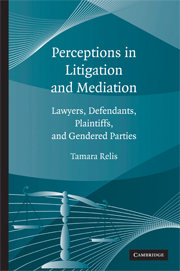Book contents
- Frontmatter
- Contents
- List of tables
- List of figures
- List of abbreviations
- Acknowledgments
- 1 Introduction
- 2 Great misconceptions or disparate perceptions of plaintiffs' litigation aims?
- 3 The voluntary versus mandatory mediation divide
- 4 Consequences of power: Legal actors versus disputants on defendants' attendance at mediation
- 5 Actors' mediation objectives: How lawyers versus parties plan to resolve their cases short of trial
- 6 Perceptions during mediations
- 7 Parallel views on mediators and styles
- 8 Conclusion: The parallel understandings and perceptions in case processing and mediation
- Bibliography
- Index
5 - Actors' mediation objectives: How lawyers versus parties plan to resolve their cases short of trial
Published online by Cambridge University Press: 21 August 2009
- Frontmatter
- Contents
- List of tables
- List of figures
- List of abbreviations
- Acknowledgments
- 1 Introduction
- 2 Great misconceptions or disparate perceptions of plaintiffs' litigation aims?
- 3 The voluntary versus mandatory mediation divide
- 4 Consequences of power: Legal actors versus disputants on defendants' attendance at mediation
- 5 Actors' mediation objectives: How lawyers versus parties plan to resolve their cases short of trial
- 6 Perceptions during mediations
- 7 Parallel views on mediators and styles
- 8 Conclusion: The parallel understandings and perceptions in case processing and mediation
- Bibliography
- Index
Summary
Following chronologically from actors' views on who should attend mediation, this chapter explores the final pre-mediation topic of what actors specifically plan for and aim to achieve during mediations, which may resolve their cases short of trial. To put this chapter in context, although supporting the findings in chapter two on plaintiffs' motivations to sue and their consequent litigation aims, this chapter is distinct. Chapter two deals with plaintiffs' versus lawyers' understandings of plaintiffs' litigation aims alone, which provides context to actors' perspectives during case processing. However, chapter two does not relate to mediation per se – only to litigation. Nor does it examine the aims of any actors other than those of plaintiffs. In contrast, this chapter focuses solely on aims for mediation. Moreover, it examines and compares all actors' articulated objectives for the process, not simply those of plaintiffs.
The findings here are striking, although not completely unexpected. Mediation actors' aims were generally found to be disparate as between legal and lay groups. Significantly, the data also demonstrate that what plaintiffs want from litigation and the civil justice system can be expressed during mediation. Moreover, as plaintiffs' mediation aims are seen to be even more focused on extralegal dispute issues than their articulated litigation aims (chapter two), I argue that as with legal actors, mediation acts to reorient parties' attention toward the extralegal aspects of their cases.
These findings add to the dearth of extant knowledge on participants' objectives for mediation.
- Type
- Chapter
- Information
- Perceptions in Litigation and MediationLawyers, Defendants, Plaintiffs, and Gendered Parties, pp. 129 - 155Publisher: Cambridge University PressPrint publication year: 2009

